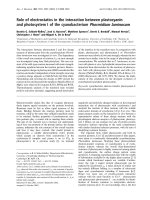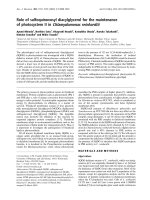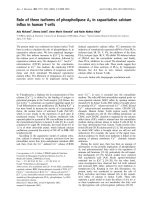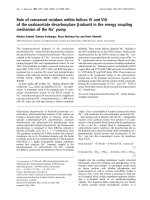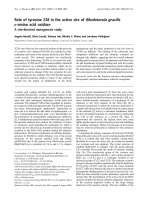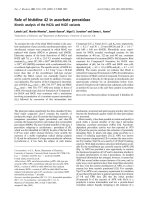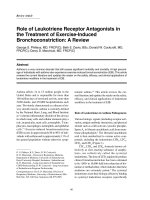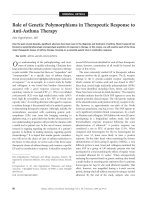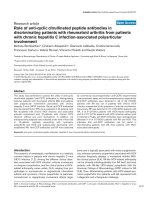Báo cáo y học: "Role of anti-cyclic citrullinated peptide antibodies in discriminating patients with rheumatoid arthritis from patients with chronic hepatitis C infection-associated polyarticular involvement" potx
Bạn đang xem bản rút gọn của tài liệu. Xem và tải ngay bản đầy đủ của tài liệu tại đây (53.22 KB, 5 trang )
Introduction
The presence of extrahepatic manifestations is a relatively
common feature in patients with chronic hepatitis C virus
(HCV) infection [1,2]. Among the different clinical disor-
ders associated with HCV infection, articular involvement
is a frequent complication, and the clinical picture of HCV-
related arthropathy varies widely [3,4], ranging from pol-
yarthralgia to monoarticular or oligoarticular intermittent
arthritis and symmetric chronic polyarthritis. In particular,
monoarticular or oligoarticular involvement affects larger
joints and is typically associated with mixed cryoglobuline-
mia, whereas symmetric polyarthritis associated with HCV
infection frequently displays a rheumatoid arthritis (RA)-
like clinical picture [3,4]. RA-like HCV-related arthropathy
can be clinically indistinguishable from RA itself, and most
patients with RA-like HCV-related polyarthritis fulfil the
American College of Rheumatology (ACR) criteria for RA
[5,6]. Thus, differentiating patients with HCV-related sym-
metric polyarthritis from patients with RA represents both
a diagnostic and a therapeutic challenge.
ACR = American College of Rheumatology; AKA = anti-keratin antibodies; anti-CCP = anti-cyclic citrullinated peptide; HCV = hepatitis C virus;
RA = rheumatoid arthritis; RF = rheumatoid factor.
Available online />Research article
Role of anti-cyclic citrullinated peptide antibodies in
discriminating patients with rheumatoid arthritis from patients
with chronic hepatitis C infection-associated polyarticular
involvement
Michele Bombardieri*, Cristiano Alessandri*, Giancarlo Labbadia, Cristina Iannuccelli,
Francesco Carlucci, Valeria Riccieri, Vincenzo Paoletti and Guido Valesini
Cattedra di Reumatologia, Dipartimento di Clinica e Terapia Medica Applicata – Università degli Studi di Roma ‘La Sapienza’, Roma, Italy
*These authors contributed equally in this study.
Corresponding author: Guido Valesini (e-mail: )
Received: 12 Dec 2003 Accepted: 13 Jan 2004 Published: 29 Jan 2004
Arthritis Res Ther 2004, 6:R137-R141 (DOI 10.1186/ar1041)
© 2004 Bombardieri et al., licensee BioMed Central Ltd (Print ISSN 1478-6354; Online ISSN 1478-6362). This is an Open Access article:
verbatim copying and redistribution of this article are permitted in all media for any purpose, provided this notice is preserved along with the
article's original URL.
Abstract
This study was performed to assess the utility of anti-cyclic
citrullinated peptide (anti-CCP) antibodies in distinguishing
between patients with rheumatoid arthritis (RA) and patients
with polyarticular involvement associated with chronic
hepatitis C virus (HCV) infection. Serum anti-CCP antibodies
and rheumatoid factor (RF) were evaluated in 30 patients with
RA, 8 patients with chronic HCV infection and associated
articular involvement and 31 patients with chronic HCV
infection without any joint involvement. In addition, we
retrospectively analysed sera collected at the time of first visit
in 10 patients originally presenting with symmetric
polyarthritis and HCV and subsequently developing well-
established RA. Anti-CCP antibodies and RF were detected
by commercial second-generation anti-CCP2 enzyme-linked
immunosorbent assay and immunonephelometry respectively.
Anti-CCP antibodies were detected in 23 of 30 (76.6%)
patients with RA but not in patients with chronic HCV
infection irrespective of the presence of articular involvement.
Conversely, RF was detected in 27 of 30 (90%) patients with
RA, 3 of 8 (37.5%) patients with HCV-related arthropathy
and 3 of 31 (9.7%) patients with HCV infection without joint
involvement. Finally, anti-CCP antibodies were retrospectively
detected in 6 of 10 (60%) patients with RA and HCV. This
indicates that anti-CCP antibodies can be useful in
discriminating patients with RA from patients with HCV-
associated arthropathy.
Keywords: anti-cyclic citrullinated peptide antibodies, hepatitis C virus, rheumatoid arthritis, rheumatoid factor
Open Access
R137
R138
Arthritis Research & Therapy Vol 6 No 2 Bombardieri et al.
Because the classic clinical picture of RA is not entirely
helpful in differential diagnosis, other diagnostic tools,
such as the detection of serologic abnormalities in sera of
patients with RA, could be helpful in differentiating
between these disorders. In this regard, however, the
detection of classic IgM rheumatoid factor (RF) is of little
utility as a diagnostic tool because a high percentage of
patients with chronic HCV infection display serum RF
reactivity, and the frequency of RF increases in patients
with articular involvement [4,5].
In contrast, the currently available test – anti-CCP2 – for
anti-cyclic citrullinated peptide (anti-CCP) antibodies has
been shown to display a high specificity for RA accompa-
nied by a reasonable high sensitivity [7–9]. Moreover,
detection of anti-CCP antibodies is a useful diagnostic
tool, particularly in the early stages of the disease, and a
predictive factor in terms of disease progression and radi-
ological damage [10–13]. However, so far no study has
focused on the possible utility of anti-CCP antibodies in
differentiating RA from HCV-related arthropathy.
The aim of this study was to evaluate, in a cohort of consec-
utive patients with chronic HCV infection, whether anti-CCP
antibodies are useful in distinguishing between patients
with HCV-related arthropathy and patients with RA.
Materials and methods
Patient sera
All the patients enrolled in this study were referred to the
Department ‘Clinica e Terapia Medica Applicata’ of the
University of Rome ‘La Sapienza’.
To identify HCV patients with HCV-related arthropathy we
enrolled 39 consecutive in-patients (16 females, 23 males;
mean age 59 years, range 37–79) affected by chronic HCV
infection that had been diagnosed on the basis of the pres-
ence of anti-HCV antibodies and confirmed by the detection
of viral RNA in serum and who were undergoing hepatic
biopsy. All the patients were subjected to careful historical
interview and rheumatologic examination. On the basis of
the presence of HCV-related arthropathy we identify two
groups of HCV patients: group 1, including patients with
articular involvement (8 patients), and group 2, comprising
patients without articular involvement (31 patients).
To compare the prevalence of anti-CCP antibodies in
HCV patients with that in patients affected by RA we
enrolled 30 consecutive in-patients fulfilling the ACR crite-
ria for RA (21 females, 9 males; mean age 60 years, range
35–75). Bleeding was performed after informed consent
had been obtained; serum was recovered and then stored
at −20°C until assayed.
To establish whether anti-CCP antibodies could help in
the early diagnosis of RA in patients with HCV infection, in
which the diagnostic role of RF is limited, we retrospec-
tively analysed 10 patients (all females; mean age
55 years, range 44–73), initially referred to our depart-
ment, presenting with symmetric polyarticular involvement
and chronic HCV infection and subsequently developing
an erosive pattern with a definite diagnosis of RA. Five of
these patients were positive for RF. In this case, autoanti-
body detection was performed on sera collected at the
time of first visit.
Anti-CCP antibodies and RF assays
Anti-CCP antibodies were detected with commercial
enzyme-linked immunosorbent assay kits (DIASTAT™ anti-
CCP; Axis Shield, Dundee, Scotland) in accordance with
the manufacturer’s instructions. In brief, microtitre plates
were incubated for 60 min at 22°C with serum samples
diluted 1 : 100 in phosphate-buffered saline. Pre-diluted
anti-CCP standards and positive and negative controls
were added to each plate. All assays were performed in
duplicate. After three washes, plates were incubated for
30 min at 22°C with alkaline phosphatase-labelled murine
monoclonal antibody against human IgG. After three
washes, the enzyme reaction was developed for 30 min and
stopped with sodium hydroxide–EDTA–carbonate buffer,
and plates were read (SPECTRA II; SLT Labinstruments,
Grödig, Austria) at 550 nm. Anti-CCP antibodies were
considered to be positive when the absorbance was
higher than the cut-off of the kit (5 U/ml). The concentra-
tion of anti-CCP antibodies was estimated by interpolation
from a dose–response curve based on standards.
RF was assayed with a quantitative immunonephelometry
test (Behring, Marburg, Germany). RF was considered to
be positive when the concentration was higher than the
cut-off value of the kit (15 IU/ml).
All serum samples with a high concentration of RF or anti-
CCP antibodies were further quantified after further dilution.
Statistical analysis
The
χ
2
test or Fisher’s exact test was used as appropriate
to compare qualitative variables in the different groups;
P < 0.05 was considered statistically significant.
Ethics
Informed consent was obtained from each patient and the
local ethics committee approved the study protocol.
Results
The main demographic and clinical characteristics of RA
and HCV patients are summarised in Tables 1 and 2
respectively. All patients affected by RA received treat-
ment with various disease-modifying antirheumatic drugs.
Articular involvement was observed in 20.5% (8 of 39) of
HCV patients. Three of the eight (37.5%) HCV patients
R139
with articular involvement showed clinical evidence of a
RA-like pattern characterised by a nonerosive symmetric
polyarthritis that affected the small diarthrodial joints of the
hands, whereas the remaining five patients were affected
by diffuse polyarthralgia. In patients with HCV, histological
examination of hepatic biopsies showed a grading of activ-
ity from minimum to severe, with no difference between
the two groups.
The prevalence of anti-CCP antibodies and RF in each
group of patients is shown in Table 3: 23 patients with RA
(76.6%) were positive for anti-CCP antibodies and 27
(90%) for RF, whereas no patient with HCV was positive
for anti-CCP antibodies and 15.4% were positive for RF
(P < 0.0001 in both cases). Interestingly, the prevalence
of RF-positive patients increased to 37.5% in patients
affected by HCV presenting with articular involvement (3
of 8), and 66.7% in patients with RA-like polyarthritis (2 of
3).
When we retrospectively analysed sera collected from
10 HCV patients with RA at the time of presentation we
detected anti-CCP antibodies in 60% of them.
Discussion
Extrahepatic manifestations are frequently observed in
patients with chronic HCV infection, with a prevalence of
more than 74% [1]. In a prospective study on a large
cohort of HCV patients, articular involvement represented
the most common extrahepatic manifestation, affecting
nearly 20% of patients in a 1-year follow-up [14].
Although it is not possible to identify a specific pattern of
HCV-related arthropathy, two different clinical subsets of
arthritis have mainly been described (reviewed in [4]): a
monoarticular–oligoarticular intermittent arthritis affecting
large and medium-sized joints and almost invariably asso-
ciated with the presence of mixed cryoglobulinaemia
[3,15] and a polyarticular symmetrical arthritis closely
resembling RA [3,5,16]. Differential diagnosis between
HCV-related polyarthritis and ‘true’ RA is often very diffi-
cult because most patients with HCV-related polyarthritis
fulfil the ACR criteria for RA [4,5]. Thus, because of the
lack of reliable clinical parameters able to differentiate
between the two diseases, other markers are needed for
the differential diagnosis.
Available online />Table 1
Clinical and demographic characteristics of patients with RA
RA RA–HCV
Variable (n = 30) (n = 10)
Age (years), mean (range) 60 (35–75) 55 (44–73)
Disease duration (years), 10 (2.5–13.5) 0.5 (0.5–11)
median (interquartile range)
ESR (mm/h), mean ± SD 42 ± 24 50 ± 35
CRP (mg/l), mean ± SD 24 ± 22 34 ± 23
CRP, C-reactive protein; ESR, erythrocyte sedimentation rate;
interquartile range, 25th–75th; RA, rheumatoid arthritis; RA–HCV,
hepatitis C virus-related RA-like polyarthritis.
Table 2
Clinical and demographic characteristics of patients with HCV
HCV without HCV with
articular articular
involvement involvement
Variable (n = 31) (n = 8)
Age (years), mean (range) 58 (35–75) 67 (50–79)
Polyarthritis, no. (%) 0 (0) 3 (37.5)
Polyarthralgias, no. (%) 0 (0) 5 (62.5)
Cryoglobulinemia, no. (%) 5 (16) 2 (25)
Transaminase U/L, mean ± SD
ALT 74±41 72±29
AST 119±79 102±47
Liver biopsy
*
Slight activity hepatitis 12 3
Minimum activity hepatitis 4 0
Moderate activity hepatitis 8 1
Severe activity hepatitis 5 2
HCV genotype
†
1a 2 0
2a 2 2
3a 2 0
2a/2c 4 0
1b 17 4
4c/4d 2 0
*
Four biopsies lacking.
†
Four genotypes lacking.
ALT, alanine aminotransferase; AST, aspartate aminotransferase; HCV,
hepatitis C virus; U/L, unit/liter.
Table 3
Prevalence of anti-CCP antibodies and RF in the serum of
patients enrolled in this study
HCV without HCV with
articular articular
involvement involvement
Variable RA (n = 30) (n = 31) (n = 8)
Anti-CCP, no. (%) 23 (76.6) 0 (0) 0 (0)
RF, no. (%) 27 (90) 3 (9.7) 3 (37.5)
Anti-CCP, anti-cyclic citrullinated peptide; HCV, hepatitis C virus; RA,
rheumatoid arthritis; RF, rheumatoid factor.
Together with the classical clinical features of the disease,
serological abnormalities, such as the presence of RF, are
usually useful in the diagnosis of RA, and RF is included in
the ACR criteria for RA. However, in cases of HCV-related
arthropathy, RF detection is not very useful because it is
often observed in sera of patients with HCV. In particular,
classic IgM RF can be detected in more than 60% of
patients with HCV-related arthropathy [5]. Moreover, even
IgA RF, which has been suggested to be useful in distin-
guishing between RA and HCV-related polyarthritis [4],
failed to demonstrate any specificity for RA compared with
HCV-related arthropathy [17].
Recently, anti-keratin antibodies (AKA) have been shown
to be useful in distinguishing between RA and HCV-
related arthropathy [18]. However, although characterised
by a high specificity, AKA display a rather low sensitivity
for RA [19]; moreover, the detection of AKA is laborious,
difficult to standardise and of limited clinical utility. The
limits displayed by AKA and later by the tests for detection
of anti-filaggrin antibodies [19] were largely overcome
after the discovery of citrulline residues as the main anti-
genic target of AKA and anti-filaggrin antibodies and the
subsequent development of an immunoenzymatic test
using cyclic citrullinated peptide to detect anti-CCP anti-
bodies [20]. The currently available so-called second-gen-
eration test, anti-CCP2, has been shown to retain a high
specificity for RA accompanied by a reasonable (about
80%) sensitivity [7,9]. In addition, anti-CCP antibodies
have been showed to be useful diagnostic tools even in
the early stages of the disease and predictive factors both
in terms of disease progression and radiological damage
[10–13].
In this study we demonstrated that anti-CCP antibodies
are able to differentiate patients with HCV-related
arthropathy from patients with RA. In our population of
consecutive chronic HCV patients we identified eight
patients with HCV-related articular involvement. Three
patients presented chronic polyarthritis that was clinically
indistinguishable from RA. Remarkably, 37.5% (three of
eight) of patients with HCV-related articular involvement
and 66.7% (two of three) of patients with RA-like poly-
arthritis were positive for RF, whereas no patients dis-
played anti-CCP reactivity. In contrast, we confirmed the
increased sensitivity of the anti-CCP2 test with a preva-
lence of 76.6% in our patients with RA, comparable with
that obtained in recent studies [7,8].
In addition, when we retrospectively analysed the preva-
lence of anti-CCP antibodies in patients presenting with
symmetric polyarthritis and HCV infection who subse-
quently developed a well-established erosive RA, we
demonstrated that anti-CCP antibodies were present in
60% of patients at the time of first visit. Although confir-
mation is needed in a larger cohort of patients with HCV-
related RA-like polyarthritis, these results suggest that
anti-CCP antibodies can be useful in differential diagnosis
with RA.
Differentiating between patients with RA and those with
HCV-related arthropathy has great relevance in clinical
practice. In fact, in contrast with RA, RA-like HCV-related
arthropathy usually shows a relatively benign course that is
not associated with bony erosions and joint deformation
[4,5,16]. Thus, management of HCV-related arthropathy
usually does not require the use of heavy immunosuppres-
sive treatment [4,21], which is associated with potential
hepatotoxicity as demonstrated in patients with RA with
concomitant chronic HCV infection [22] or may worsen
the evolution of liver damage in HCV-affected patients.
Thus, an early differential diagnosis could be of great
importance in establishing the correct treatment to
prevent joint erosions in patients with ‘true’ RA as well as
chronic HCV infection and reducing the risk of immuno-
suppressive therapy in patients with HCV-related
arthropathy.
Conclusion
In this study we provide evidence that anti-CCP antibod-
ies are absent from the serum of patients with chronic
HCV infection and associated articular involvement, and
we confirm the high specificity and good sensitivity of anti-
CCP2 for RA. In particular, the demonstration that the test
for anti-CCP antibodies is negative in patients with HCV-
related RA-like arthropathy who are seropositive for RF
indicates that anti-CCP antibodies can be useful in dis-
criminating patients with RA from patients with HCV-asso-
ciated arthropathy.
Competing interests
None declared.
References
1. Cacoub P, Poynard T, Ghillani P, Charlotte F, Olivi M, Piette JC,
Opolon P: Extrahepatic manifestations of chronic hepatitis C.
MULTIVIRC Group (Multidepartment Virus C). Arthritis Rheum
1999, 42:2204-2212.
2. Mariette X: The hepatitis C virus and systemic diseases. Rev
Rheum 1998, 65:737-740.
3. Rivera J, Garcia-Monforte A, Pineda A, Millan Nunez-Cortes J:
Arthritis in patients with chronic hepatitis C virus infection. J
Rheumatol 1999, 26:420-424.
4. Olivieri I, Palazzi C, Padula A: Hepatitis C virus and arthritis.
Rheum Dis Clin North Am 2003, 29:111-122.
5. Zuckerman E, Keren D, Rozenbaum M: Hepatitis C virus related
arthritis: characteristics and response to therapy with inter-
feron alpha. Clin Exp Rheumatol 2000, 18:579-584.
6. Arnett FC, Edworthy SM, Bloch DA: The American Rheumatism
Association 1987 revised criteria for the classification of
rheumatoid arthritis. Arthritis Rheum 1988, 31:315-324.
7. Vasishta A: Diagnosing early-onset rheumatoid arthritis: the
role of anti-CCP antibodies. Am Clin Lab 2002, 21:34-36.
8. Pinheiro GC, Scheinberg MA, Aparecida da Silva M, Maciel S:
Anti-cyclic citrullinated peptide antibodies in advanced
rheumatoid arthritis. Ann Intern Med 2003, 139:234-235.
9. van Venrooij WJ, Hazes JM, Visser H: Anticitrullinated protein/
peptide antibody and its role in the diagnosis and prognosis
of early rheumatoid arthritis. Neth J Med 2002, 60:383-388.
Arthritis Research & Therapy Vol 6 No 2 Bombardieri et al.
R140
10. Schellekens GA, Visser H, de Jong BA, van den Hoogen FH,
Hazes JM, Breedveld FC, van Venrooij WJ: The diagnostic prop-
erties of rheumatoid arthritis antibodies recognizing a cyclic
citrullinated peptide. Arthritis Rheum 2000, 43:155-163.
11. Kroot EJ, de Jong BA, van Leeuwen MA, Swinkels H, van den
Hoogen FH, van’t Hof M, van de Putte LB, van Rijswijk MH, van
Venrooij WJ, van Riel PL: The prognostic value of anti-cyclic cit-
rullinated peptide antibody in patients with recent-onset
rheumatoid arthritis. Arthritis Rheum 2000, 43:1831-1835.
12. Meyer O, Labarre C, Dougados M, Goupille P, Cantagrel A,
Dubois A, Nicaise-Roland P, Sibilia J, Combe B: Anticitrullinated
protein/peptide antibody assays in early rheumatoid arthritis
for predicting five year radiographic damage. Ann Rheum Dis
2003, 62:120-126.
13. Bas S, Genevay S, Meyer O, Gabay C: Anti-cyclic citrullinated
peptide antibodies, IgM and IgA rheumatoid factors in the
diagnosis and prognosis of rheumatoid arthritis. Rheumatol-
ogy 2003, 42:677-680.
14. Cacoub P, Renou C, Rosenthal E, Cohen P, Loury I, Loustaud-
Ratti V, Yamamoto AM, Camproux AC, Hausfater P, Musset L,
Veyssier P, Raguin G, Piette JC: Extrahepatic manifestations
associated with hepatitis C virus infection. A prospective mul-
ticenter study of 321 patients. The GERMIVIC (Groupe
d’Étude et de Recherche en Médecine Interne et Maladies
Infectieuses sur le Virus de l’Hépatite C). Medicine (Baltimore)
2000, 79:47-56.
15. Fadda P, La Civita L, Zignego AL, Ferri C: Hepatitis C virus
infection and arthritis. A clinico-serological investigation of
arthritis in patients with or without cryoglobulinemic sin-
drome. Reumatismo 2002, 54:316-323.
16. Lovy MR, Starkebaum G, Uberoi S: Hepatitis C infection pre-
senting with rheumatic manifestations: a mimic of rheumatoid
arthritis. J Rheumatol 1996, 23:979-983.
17. Toubi E, Zuckerman E, Kessel A, Rozenbaum M, Rosner I: IgA
rheumatoid factor in patients with chronic HCV infection:
prevalence and clinical correlations. Clin Exp Rheumatol 2003,
21:524.
18. Kessel A, Rosner I, Zuckerman E, Golan TD, Toubi E: Use of
antikeratin antibodies to distinguish between rheumatoid
arthritis and polyarthritis associated with hepatitis C infection.
J Rheumatol 2000, 27:610-612.
19. van Boekel MAM, Vossenaar ER, van den Hoogen FHJ, van Ven-
rooij WJ: Autoantibody systems in rheumatoid arthritis: speci-
ficity, sensitivity and diagnostic value. Arthritis Res 2002, 4:
87-93.
20. Schellekens GA, de Jong BA, van den Hoogen FH, van de Putte
LB, van Venrooij WJ: Citrulline is an essential constituent of
antigenic determinants recognized by rheumatoid arthritis-
specific autoantibodies. J Clin Invest 1998, 101:273-281.
21. Zuckerman E, Yeshurun D, Rosner I: Management of hepatitis C
virus-related arthritis. BioDrugs 2001, 15:573-584.
22. Mok MY, Ng WL, Yuen MF, Wong RW, Lau CS: Safety of
disease modifying anti-rheumatic agents in rheumatoid
arthritis patients with chronic viral hepatitis. Clin Exp Rheuma-
tol 2000, 18:363-368.
Correspondence
Guido Valesini, Dipartimento di Clinica e Terapia Medica Applicata,
Cattedra di Reumatologia, Università ‘La Sapienza’, V.le del Policlinico
155, 00161 Roma, Italy. Tel and fax : +39 064469273; e-mail:
Available online />R141
